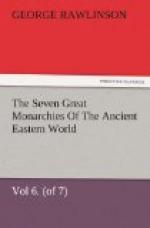was for the most part unknown to the Romans.
When Persia, about A.D. 220, revolted from Artabanus,
it was no doubt with a conviction that the Parthians
were no longer the terrible warriors who under Mithridates
I. had driven all the armies of the East before them
like chaff, or who under Orodes and Phraates IV. had
gained signal victories over the Romans. It is
true that Artabanus had contended not unsuccessfully
with Macrinus. But the prestige of Parthia was
far from being re-established by the result of his
three days’ battle. Rome retained as her
own, notwithstanding his success, the old Parthian
province of Mesopotamia, and was thus, even in the
moment of her weakness, acknowledged by Parthia to
be the stronger. The Persians are not likely
to have been braver or more warlike at the time of
their revolt from Artabanus than in the days when they
were subjected by Mithridates. Any alteration,
therefore, in the relative strength of the two peoples
must be ascribed to Parthian decline, since it cannot
have been owing to Persian advance and improvement.
To conclude, we may perhaps allow something to the
personal qualities of Artaxerxes, who appears to have
possessed all the merits of the typical Oriental conqueror.
Artabanus was among the most able of the later Parthian
monarchs; but his antagonist was more than this, possessing
true military genius. It is quite possible that,
if the leaders on the two sides had changed places,
the victory might have rested, not with the Persians,
but with the Parthians.
CHAPTER XXII.
On the Architecture and Ornamental Art of the Parthians.
The modern historian of Architecture observes, when
he reaches the period with which we have had to deal
in this volume, that, with the advent of Alexander,
Oriental architecture disappears, and that its history
is an absolute blank from the downfall of the Achaemenians
in B.C. 331 to the rise of the Sassanians, about A.D.
226. The statement made involves a certain amount
of exaggeration; but still it expresses, roughly and
strongly, a curious and important fact. The Parthians
were not, in any full or pregnant sense of the word,
builders. They did not aim at leaving a material
mark upon the world by means of edifices or other
great works. They lacked the spirit which had
impelled successively the Assyrians, the Babylonians,
and the Persians to cover Western Asia with architectural
monuments, proofs at once of the wealth, and the grand
ideas, of those who raised them. Parthia, compared
to these pretentious empires, was retiring and modest.
The monarchs, however rich they may have been, affected
something of primitive rudeness and simplicity in
their habits and style of life, their dwellings and
temples, their palaces and tombs. It is difficult
indeed to draw the line in every case between pure
Parthian work and Sassanian; but on the whole there
is, no doubt, reason to believe that the architectural




